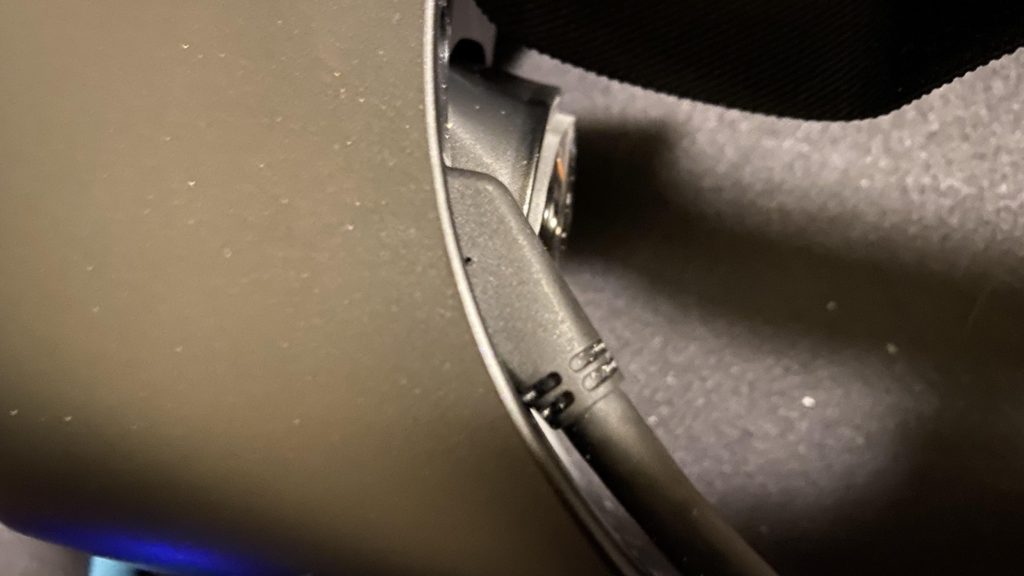See also
- Microsoft’s Reverb G2 FAQ & troubleshooting guide
- Windows Mixed Reality VR help portal
- Setting up SteamVR with WMR (Windows Mixed Reality)
- Recommendations for ideal tracking connections
- Microsoft WMR Error codes help
- FAQ and troubleshooting post on reddit
- Tips & tricks reddit post
- How to file a bug for WMR – HP highly recommends filing a bug there
Generally applicable tips
- Whatever problem you’re having, try updating Windows. G2 software and drivers are updated through Windows update, so make sure you have the newest version.
Headset not working
- Make sure the headset connector is pushed all the way in. There is a dot on the connector. When the connector is connected correctly, the dot should be right against the HMD. You only need a small force to insert the connector, it just has to be aligned properly. Wiggle it a little when inserting, try moving it up and down, left and right, also tilting it. Try different insertion angles. Just wiggle, wiggle, wiggle! If you don’t succeed, try asking someone else to try, he might wiggle it differently. When fully inserted, it should look like this:

- Check if you have everything properly connected. See this post on how you should connect the headset.
- If the recommended connection setup doesn’t work, try all USB-C and USB-A connectors on your PC.
- If you’re using the USB-C to USB-A adapter provided with the G2, try connecting the USB-C the other way (it’s symmetrical so you can rotate it 180°).
- Make sure you’re using Microsoft USB drivers. There should be “Microsoft” in the name of the “eXtensible Host Controller” device. Also just try uninstalling USB drivers and installing new ones from Windows Update.
- There were reports of issues with X570 chipset motherboards (and some other chipsets apparently too) – HP is investigating it (HP reddit post). There should be a update fix eventually.
- Update Windows.
- Update your BIOS/UEFI firmware.
- Update the Windows Mixed Reality Portal in the Microsoft Store.
- Try disabling PCIe v4 (forcing PCIe v3 in BIOS).
- In Device Manager → Universal Serial Bus (USBs) controller go through each device and in the “Power Management Options” tab uncheck “Allow the computer to turn off this device”.
- Users have reported success with using powered (and also unpowered) USB hubs or PCIe expansion cards. If you have one, try it out. If not and wouldn’t mind buying one, you can get one. No guarantees though.
- Check Microsoft’s troubleshooting guide and error code list.
More stuff you can try:
- Try uninstalling Asus AI Suite if you have it installed.
- Try removing/renaming the %ProgramData%/WindowsHolographicDevices directory if things are going crazy.
- Disable Steam Home.
- Try enabling legacy USB support in your BIOS.
Broken cable clip
- HP is aware of this issue, apparently a wrong batch of the clips got into production. You can apply for RMA and they’ll send you a new one.
- You can also 3D print this community-made replacement model.
- I’m also selling a 3D printed cable clip set on Etsy.
Displays going black during games
- Download and install this firmware update from HP on your G2 headset.
Small sweet spot, blurry/distorted image
- See Achieving edge-to-edge clarity.
- Try clicking on the “Switch aspect ratio” button on the bottom right corner in the Mixed Reality Portal app.
Speakers not working properly
- Try deattaching and reattaching the speaker (iMaxx’es reddit post).
- Contact support if the issue persists.
Joysticks sticking to the sides
- Use a decent force to push the joysticks into the controllers a little more.
Tracking is not working well
- Make sure your room is lit just enough. You can check this by using the flashlight mode in the headset, looking around and veryfing that the cameras don’t see the room too dark and that they are not overblown by any light sources.
- The tracking algorithm needs clearly visible edges for proper tracking. Make sure your room is not just uniform color all around. Adding furniture, pictures, etc helps. You can also just print out some black cross markers and put them around. Or let your kids run around with a sharpie.
- Check that your controllers batteries are charged. For proper function, the controllers need 1.5V batteries (see battery buying guide).
- Try covering reflective surfaces like mirrors.
- Try avoiding using white lights – switch to warm lights/different color altogether.
- Try connecting the headset to different USB ports on your computer.
- Make sure you’re not in an elevator (based on Microsoft guide).
- Check that the headset cameras are not dirty. You can clean them using a dry microfiber cloth.
- See official Microsoft tracking conditions guide
- See Tapping’s video on tracking properties, limitations and tracking volume
Bad performance
- Try updating Windows and your GPU drivers.
- If necessary, try reducing the supersampling resolution in SteamVR.
- Check that your system meets the minimum requirements.
- Turn off in-game overlay in GeForce Experience.
- Disable the virtual monitor preallocation feature (see official Microsoft tutorial or a youtube tutorial by HoldenRiot). This can be done by simply running this registry file (created by me, it’s safe) and restarting the computer.
